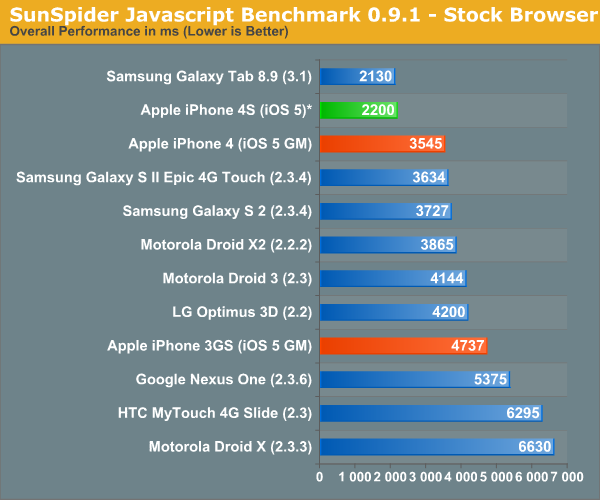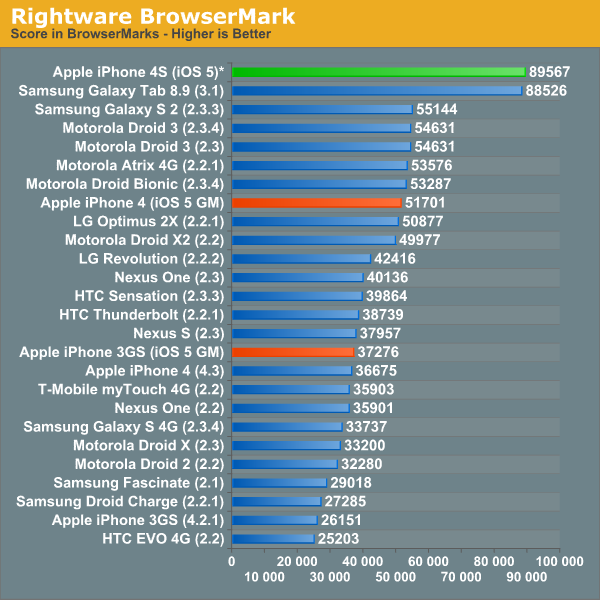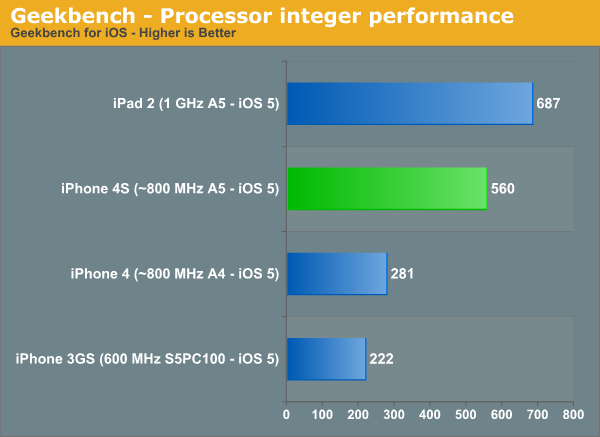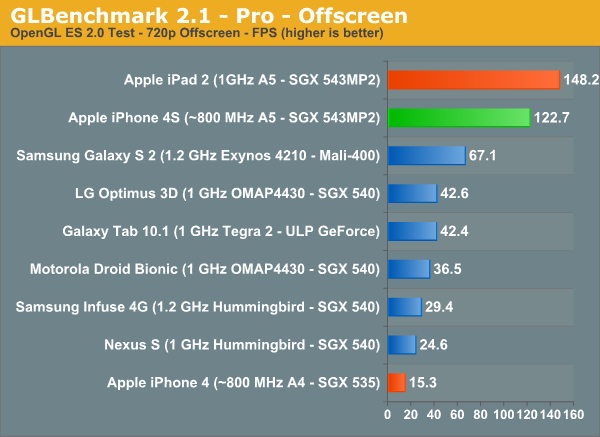iPhone 4S Preliminary Benchmarks: ~800MHz A5, Slightly Slower GPU than iPad 2, Still Very Fast
by Anand Lal Shimpi & Brian Klug on October 11, 2011 3:22 AM EST- Posted in
- Smartphones
- Apple
- Mobile
- iPhone 4S
- SoCs
Apple's ability to control the entire information chain, down to the point of limiting leaks, appears to be gradually slipping as it grows as a company. Case in point are the numerous hardware and performance leaks surrounding the newly launched iPhone 4S. Little did we know that several weeks ago we were staring at photos of the 4S' PCB, and more recently we've seen the first performance results from Apple's first A5 based smartphone thanks to a few eager users around the web. We've compiled these results here from various sources (all linked below) and compared them to our existing database of tests.
The results are pretty much as expected. Javascript performance finally catches up to Tegra 2 based Honeycomb devices, while general CPU performance is significantly higher than the iPhone 4. I suspect Ice Cream Sandwich will bridge the Android smartphone gap (the Honeycomb equipped Gtab 8.9 is here to give you an idea of where a more modern Android browser ends up).
Keep in mind that all of these tests measure performance of the software stack in addition to the hardware. In particular the web browser tests depend largely on browser optimizations, which is why we see differences between similar hardware running different browser versions. Also note that all results were run at stock, with the stock browser. Finally, although these browser tests were captured on video we'll still be running our official tests once our 4Ses arrive and will update accordingly.


Using some of the integer and fp tests of published Geekbench scores we can already conclude that Apple is shipping a lower clocked A5 in the iPhone 4S than it does in the iPad 2. This naturally makes sense as the iPhone 4S has a much smaller 5.25 Whr battery. Based on the Geekbench results it looks like the iPad 2 is clocked around 25% higher than the iPhone 4S, pegging the latter's clock speed at 800MHz.


A lower clock not only means higher yields from the factory, but likely a lower operating voltage as well. Dropping a CPU's core voltage, yields a greater-than-linear decrease in power consumption, making the marginal loss in clock speed a good choice. At a lower operating frequency than its Android competitors, Apple does have to exploit its strengths in software to avoid any tangible performance penalties. Apple has traditionally done this very well in the past, so I don't expect the loss of frequency to be a huge deal to the few who do cross-shop iOS and Android.
Unsurprisingly, memory bandwidth doesn't appear to have gone up either compared to the iPad 2's A5 (taking into account scaling due to CPU clock increases). The Samsung part number on the iPad 2's A5 indicates two LPDDR2-800 die on package, it's safe to assume that whatever Apple clocked the memory interface at in the iPad 2 remains unchanged in the iPhone 4S.
The GPU results tell a similar story courtesy of some early GLBenchmark 2.1 results. The 960 x 640 results are useless as they are bound by vsync at ~60 fps. Luckly GLBenchmark 2.1 added an off-screen render mode at 1280 x 720 where we can really see the differences between the iPad 2 and iPhone 4S A5 implementations:


Here the iPad 2 holds a ~21% performance advantage, which once again I assume to be all related to clock speed. Also note the huge advantage over the existing iPhone 4. The GPU power in the 4S should be more than enough to run any well written, current generation title at well north of 30 fps on its display.
We'll be reviewing the iPhone 4S in the coming weeks, stay tuned!
Source: GLBenchmark Database, Geekbench Database, Macrumors










216 Comments
View All Comments
Lucian Armasu - Tuesday, October 11, 2011 - link
I thought the A5 GPU is that fast because it's a much larger SoC (and GPU) - twice as big as Tegra 2. Can you confirm that, Anand?tipoo - Tuesday, October 11, 2011 - link
True. Its 122mm2 compared to just 49mm2 of the Tegra 2. Even taking the transistor size difference into account, the A5 clearly has more stuff, and most is due to that MP2 dual core graphics chip.BoyBawang - Tuesday, October 11, 2011 - link
I was comparing A5 with Samsungs EXYNOS not Tegra2. If you google it, A5 and Exynos are of the same Size at about 120mm but A5 GPU performance is far ahead that's why I was praising its GPU architecture over MALIskydrome1 - Tuesday, October 11, 2011 - link
I did remember reading somewhere that the A5 is huge, and that NVIDIA commented that that allowed them to market their 80mm^2 Kal El better. I believe the Exynos is much smaller than that?WaltFrench - Tuesday, October 11, 2011 - link
<i>“the A5 is huge [122mm^2], and that NVIDIA commented that that allowed them to market their 80mm^2 Kal El better.”</i>Boy, selling that your competitor's CPU is too “huge” because it's half again as large would tax the best marketing department *I* can think of.
Assuming that Apple knows a thing or two about power management (and they do), the size doesn't mean diddly for power consumption. It therefore doesn't mean anything about heat. It can't possibly have a perceptible impact on the size of the overall device.
Instead, it'll merely tell prospective customers that your competitor has put in circuitry that they thought would be useful, worth a teensy bit of extra expense (that again won't be visible to the consumer). If Apple were to market on this level (and it doesn't), they'd ask to compare GPU-heavy benchmarks such as game speeds. If the iWhatever does at least as well as the TegraX, who cares what the size is?
There are many things about nVidia that I don't understand, but I'll move this to the top of my list.
BoyBawang - Wednesday, October 12, 2011 - link
II was comparing A5 with Samsungs EXYNOS not Tegra2. If you google it, A5 and Exynos are of the same Size at about 120mm but A5 GPU performance is far ahead that's why I was praising its GPU architecture over MALIinplainview - Tuesday, October 11, 2011 - link
Outside for the few hardcore people here that are never satisfied with anything, how will any of this matter to the average consumer to whom the iPhone is marketed at. It is all well and good to have these spec debates but really, who cares?bpcookson - Tuesday, October 11, 2011 - link
Performance is a feature. Everyone cares, just not everyone wants to know numbers.Here is an excellent post about it:
http://www.codinghorror.com/blog/2011/06/performan...
Androids tout numbers left and right, so being able to forward benchmarks of this nature to friends and coworkers is fantastic. :)
inplainview - Tuesday, October 11, 2011 - link
Good points....WaltFrench - Tuesday, October 11, 2011 - link
<i>“being able to forward benchmarks of this nature to friends and coworkers is fantastic. :)”</i>Presuming that you want to forward this to coworkers who have chosen Android because they think in these terms, I'm not clear why/how it'll be fantastic to show that Apple software upgrades, free and easily available for compatible devices, enhances older devices' results by 50%.
…or that Apple's new product is at the top of the heap of measured performance, despite others having supposedly faster CPUs and all the emphasis that Apples are just toys for the clueless.
…or that the iPad2 is off the top of the chart against EVERY Android.
Again, Apple doesn't play this game because they focus on the user experience, so I presume you are thinking these numbers will help promote Android. But they don't. Care to help me understand?